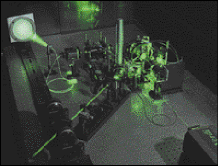Barbara Grant
Conventional ultrasound techniques require that a transducer be attached to a sample surface for both signal generation and detection. Laser ultrasound, which uses one laser pulse to generate a signal and another to detect small surface displacements, can provide a noncontact method for ultrasonic measurements. To map the results over the sample surface using either method, the detection beam must be scanned during repeated excitation of the ultrasonic signal, a time-consuming process in which only a few tens to hundreds of sample points may be collected.

The Idaho National Engineering and Environmental Laboratory's laser ultrasonic camera uses a holographic crystal to image ultrasonic waves moving across a test surface.
Speckle interferometry can provide a full image in a single acquisition, but computer interpretation of interferometric fringes is time-consuming as well. A new method and laser ultrasonic camera developed by researchers at the US Department of Energy's Idaho National Engineering and Environmental Laboratory overcomes many of the limitations of ultrasonic detection, said Vance Deason and Ken Telschow, consulting scientists at the lab.
Deason, Telschow and a team of researchers have exploited the properties of nonlinear optical materials to demodulate and detect a distribution of ultrasonic waves over a surface on the order of a square foot in size. Narrowband detection, performed at a single ultrasonic frequency, enables measurements with high signal-to-noise ratios, and the camera's architecture allows collection of about a million sample points, Deason said.
The new process uses a reference laser beam and another reflected off the sample, which recombine within a holographic crystal to produce a diffracted image whose intensity at each point is directly proportional to surface displacement. The ultrasonic camera receives scattered light from the object and refocuses it into the crystal. A standard charge-coupled device camera records the image.
"Our method is far less affected by ultrasonic dispersion problems typical of the pulsed laser methods that use very broadband detection," Deason noted. He said the technique is well-suited to "noisy industrial environments, where equipment vibrations might be many orders of magnitude higher than the ultrasonic signal."
Applications in nondestructive evaluation and testing are particularly amenable to the technique, Deason said. Although conventional ultrasound using piezoelectric transducers is relatively inexpensive and provides high sensitivity, it requires contact with the sample and can induce changes to the object under test.
The research team is collaborating with the paper industry to develop on- and off-line inspection techniques for paper properties, and is pursuing other opportunities.
